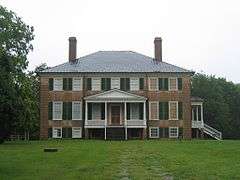Prestwould
|
Prestwould | |
|
Prestwould, June 2009 | |
  | |
| Location | N of Clarksville, Virginia |
|---|---|
| Coordinates | 36°39′19″N 78°34′14″W / 36.65528°N 78.57056°WCoordinates: 36°39′19″N 78°34′14″W / 36.65528°N 78.57056°W |
| Area | 46 acres (19 ha)[1] |
| Built | 1795 |
| Architect | Unknown |
| Architectural style | No Style Listed |
| NRHP Reference # | 69000260 |
| VLR # | 058-0045 |
| Significant dates | |
| Added to NRHP | October 1, 1969[2] |
| Designated NHL | July 31, 2003[3] |
| Designated VLR | November 5, 1968[4] |
Prestwould is a historic house near Clarksville, Virginia. It is the most intact and best documented plantation surviving in Southside Virginia. The home was built by Sir Peyton Skipwith VII, Baronet, who moved his family from his Elm Hill Plantation to Prestwould in 1797. It was declared a National Historic Landmark in 2003.[1][3][5] It is located on the north side of the Roanoke River, 1-mile (1.6 km) inland, approximately 6 miles (9.7 km) southwest of the intersection of Route 15 and Route 701, and approximately one mile north of Clarksville's city limits.[5] Now a museum property, it is open for tours from April to October, or by appointment.
Description and history
Prestwould Plantation today consists of almost 46 acres (19 ha) on the north side of the Roanoke River, its main house set on a hill overlooking the upper reaches of John H. Kerr Reservoir, a result of damming the river in the 1960s. The plantation complexincludes eight buildings, all built before 1830 and most dating to the 1780s. The house is a handsome brick building with a hip roof and a pair of interior chimneys. The main facade is symmetrical, with seven bays. The center three bays of the first floor are sheltered by a gabled porch, supported by Doric columns. Similar porches are found on two other sides of the building. The secondary buildings of the complex are all wood frame structures, and include an office, plantation store, slave quarters, and a pair of smokehouses.[1]
Prestwould Plantation was the product of land acquisition beginning in the 1760s by Peyton Skipwith, with more than 4,000 acres (1,600 ha) acquired by the 1790s. The main house was built in the 1790s, at a time when Skipwith was one of Virginia's wealthiest men. The property was owned by the Skipwith family, with only relatively modest alterations after 1830, until 1914. For five decades it was used by a variety of owners, primarily as a rural country retreat. The central portion of the estate was separated from much of its land by a sale in 1947, and the central portion was acquired by the Roanoke River Museum in 1963. Now reorganized as the Prestwould Foundation, it has overseen the property's restoration and conversion to a museum.[1]
See also
- List of National Historic Landmarks in Virginia
- National Register of Historic Places listings in Mecklenburg County, Virginia
| Wikimedia Commons has media related to Prestwould Plantation. |
References
- 1 2 3 4 Hudgins, Carter L., Edward Chappell, and John H. Sprinkle, Jr. (September 1, 2001). "National Register of Historic Places Inventory/Nomination: Prestwould" (pdf). National Park Service. and Accompanying 17 photos, exterior and interior, from 2001 and 2002 (32 KB)
- ↑ National Park Service (2007-01-23). "National Register Information System". National Register of Historic Places. National Park Service.
- 1 2 "Prestwould". National Historic Landmark summary listing. National Park Service. Retrieved 2008-04-15.
- ↑ "Virginia Landmarks Register". Virginia Department of Historic Resources. Retrieved 5 June 2013.
- 1 2 Staff, Virginia Historic Landmarks Commission, James W. Moody, Jr., Director (April 28, 1969). "National Register of Historic Places Inventory/Nomination: Prestwould" (pdf). National Park Service.
External links
- Prestwould, the house and touring information
- Prestwould, Mecklenburg County, one photo at Virginia DHR
- Prestwould Plantation, U.S. Route 15 vicinity, Clarksville vicinity, Mecklenburg County, VA: 4 photos, 23 drawings, 2 data pages, at Historic American Buildings Survey
- Scalamandre restoration work at Prestwould
